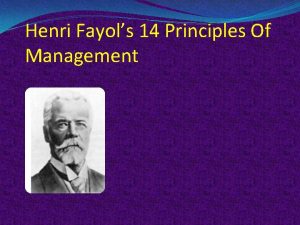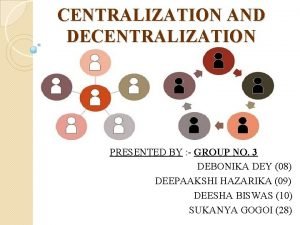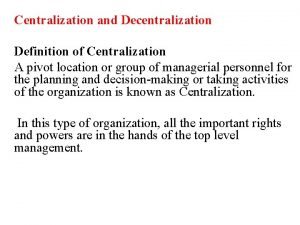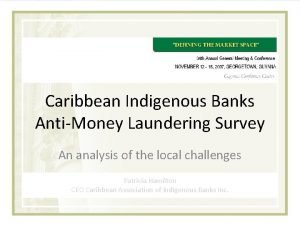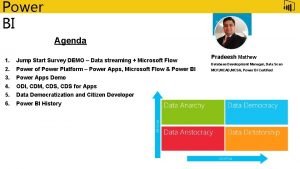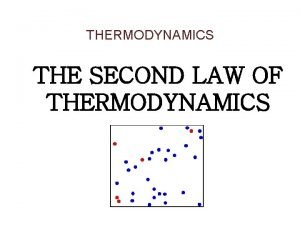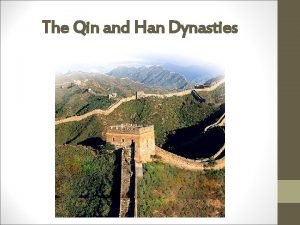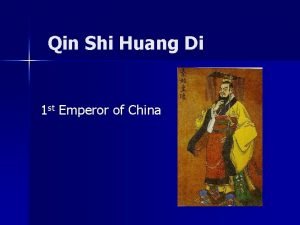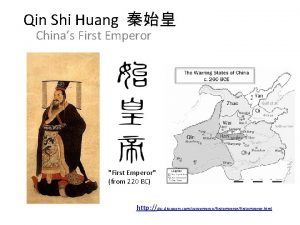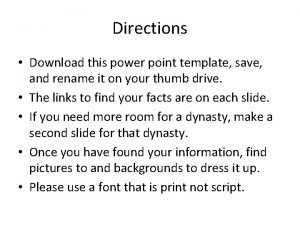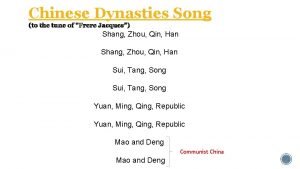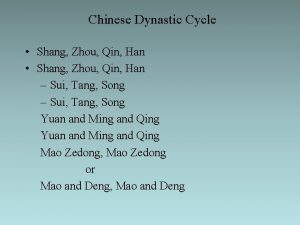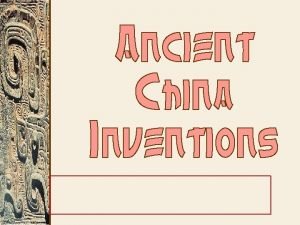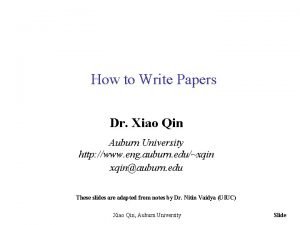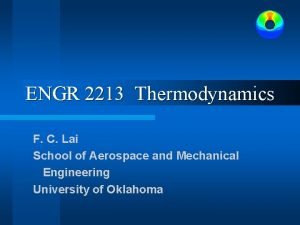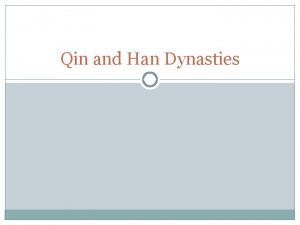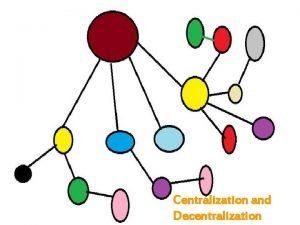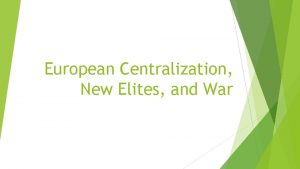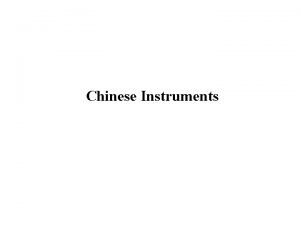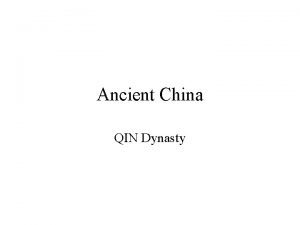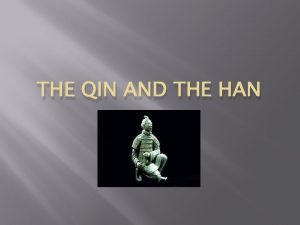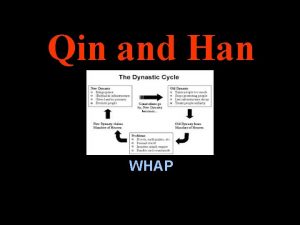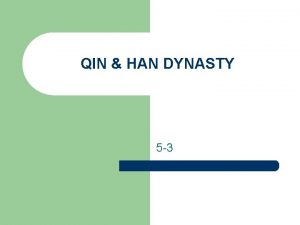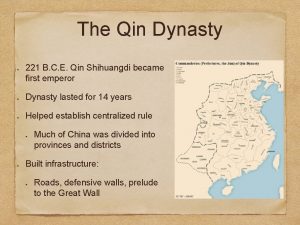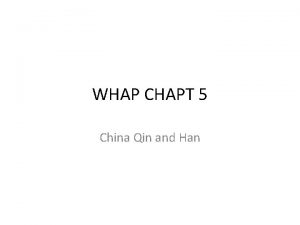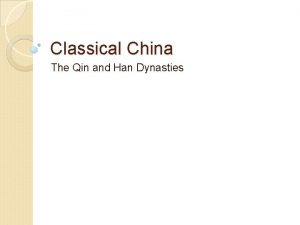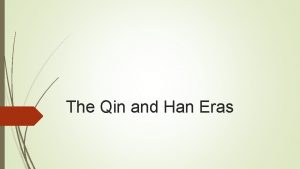Agenda PostConquest Qin 1 Centralization of power the

















- Slides: 17

Agenda Post-Conquest Qin 1. Centralization of power -- the Emperor 2. “National” unification projects • Expropriation / Standardization / Construction 3. Military consolidation and expansion • The Xiongnu 4. Defensive mobilization: • The Great Wall 5. Intellectual totalitarianism: • Burning the books & burying the scholars 6. Qin tyranny 7. The influence of Sima Qian 1

c. 1250 1045 771 453 221 206 c. 100 ---|-------|------|=|---- Late Western Spring. Warring Qin Early Shang Zhou Autumn States Han 2

1. Centralizing power The Imperial title – a new-style CEO • Huangdi 皇帝 – “August Deity” • Priority of the First Emperor – Old “naming system” (King Wen, King Wu) – New naming system • First Emperor • Generation Two • Generation Three. . . to Ten Thousand 3

2. Constructing the unified state A. Disarmament B. Expropriation of patrician lands & independence – removal to capital region C. Administrative division of territory D. Standardization of weights & measures E. Standardization of axle widths (roads) F. Standardization of writing G. Standardization of administration & law 4

A. Disarmament • Confiscation of metal weaponry – Old state armies – All private arms • Re-forging into arms for Qin army • Tools of violence monopolized by Imperial state 5

B. Expropriation of patrician lands – removal of patrician clans to capital region • Families with claims to ruling legitimacy – Deprived of titles – Removed from homeland – Transported to region of direct court supervision • Regions deprived of local political leadership 6

C. Administrative division of territory • New system of “counties” and “commanderies” • Demarcated territories under – civil administration (counties) – military administration (commanderies) • Erasure of old state territorial contours 7

County seat Commandery seat 8

D. Standardization of weights & measures; coinage • Erasure of old state market standards & barriers • Uniform system of trade market half-liang coin weight 9

E. Standardization of axle widths and road building • Elimination of barriers to regional transport on dirt roads • Construction of stonepaved roads 10

F. Standardization of writing Regional variety suppressed Universal intelligibility demanded 11

G. Standardization of administration and law Traditional accounts – Detailed codes of criminal law • Harsh and finely graded punishments • Draconian administration of law – Detailed codes of administrative law • Government officers under strict intimidation – Association of law code with Li Si • Recently discovered code books (next class) 12

3. Military Consolidation and Expansion • Expansionism & Xiongnu wars – Unifying force of Xiongnu wars • The Great Wall project – Walls & Chinese culture – Entire country aware of mobilization 13

XIONGNU TRIBES 4. Defensive Mobilization • Construction of the Great Wall – Supervised by Qin military – Enormous mobilization of manpower • Extension of Warring States era “long walls” – Defensive function – Represents consolidation of conquered steppe • Offensive base for expansion 14

5. Intellectual Totalitarianism • Proscription of all non-Legalist/Qin texts – Li Si’s great “burning of the books” • Problems with traditional account • Extermination of intellectual opposition – Live burial of Confucian scholars • Problems with traditional account 15

6. Tyranny • Arbitrary exercise of power by Emperor • Model of evil kings [Xia] Jie & [Shang] Zhòu • Absolutism in application of law – Revolt of Chen She • Cause of rapid Qin disintegration 16

7. The influence of Sima Qian 17
 Introduction of 14 principles of management
Introduction of 14 principles of management Centralization
Centralization Centralization
Centralization Centralization vs decentralization
Centralization vs decentralization Degree of centralization
Degree of centralization Agenda sistemica y agenda institucional
Agenda sistemica y agenda institucional Real power formula
Real power formula Agenda power bi
Agenda power bi Wnet = qin - qout
Wnet = qin - qout China qin dynasty map
China qin dynasty map Emperor qin quotes
Emperor qin quotes Qin shi huang ror
Qin shi huang ror Facts about the qin dynasty
Facts about the qin dynasty Chinese dynasties song
Chinese dynasties song Dynastic cycle
Dynastic cycle Qin dynasty inventions
Qin dynasty inventions Xiao qin auburn
Xiao qin auburn Wnet = qin - qout
Wnet = qin - qout
